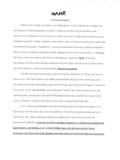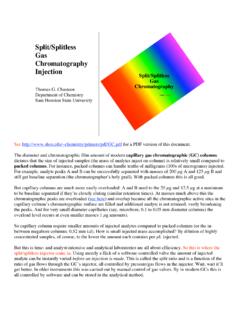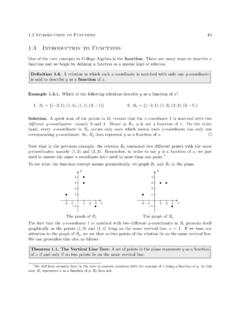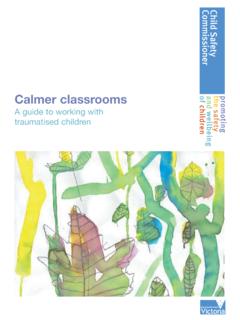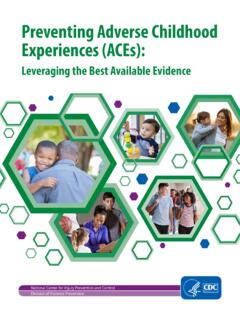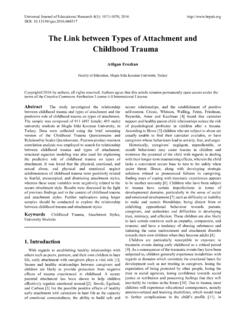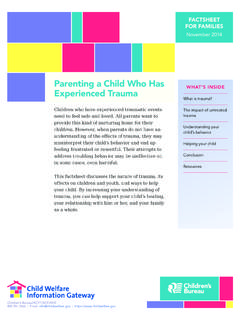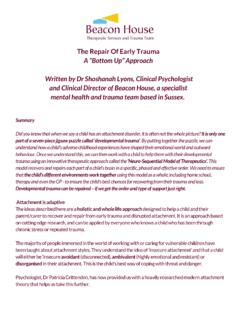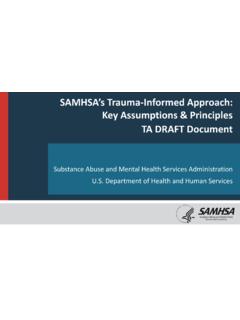Transcription of Treating Adults With Complex Trauma: An Evidence‐Based ...
1 Received 12/25/14. Revised 12/29/14. Accepted 05/30/15. DOI: Treating Adults With Complex trauma : An Evidence-Based Case Study David M. Lawson This article presents an overview of Complex trauma and a case study describing the evidence-informed treatment of a 25-year-old woman with chronic Complex trauma symptoms resulting from childhood sexual, physical, and psychological abuse from a caregiver. Treatment followed a relationship-based, cognitive behavior therapy model across 3 treatment phases. Significant reductions in trauma and general distress symptoms occurred from pre- to posttreatment, although firm conclusions about cause cannot be drawn from case studies. Verbatim vignettes illustrate specific interactions. Keywords: Complex trauma , interpersonal trauma , relationship-based cognitive behavior therapy, child sexual abuse Adults with histories of exposure to Complex trauma (CT) emotion regulation, (b) self/relational capacities, (c) altera- present daunting challenges for counselors working with tions in attention and consciousness, (d) belief systems, and this population (Courtois & Ford, 2013).
2 These clients may (e) somatic symptoms and/or medical problems. These symp- dramatically shift their opinion of the counselor from very toms most often result from prolonged exposure to multiple positive (idealization) to negative (disillusionment) in a brief forms of interpersonal trauma , typically during childhood , by period of time; exhibit sudden, extreme swings in mood; and/ caregivers who are expected to provide a safe, predictable, or anxiously anticipate abandonment by significant others and secure environment (Courtois & Ford, 2013). Typically, (Briere & Scott, 2013). The etiology of these behaviors is there is no escape from the abuse. This disruption in the care- often linked to childhood abuse and forms the substrate giver child bond compromises the development of a secure for negative intrapersonal and interpersonal relationships, attachment and a coherent, stable sense of self (Courtois &.)
3 Survival-based coping skills, and a general view of the Ford, 2013). As a result of early invalidating messages from world and others as unsafe and untrustworthy. The resulting caregivers and self-referent thinking, these individuals often symptoms continue in various forms into these individuals' develop personal schemas of self-blame for the abuse and current adult lives. The consequences associated with ex- view themselves as bad, deserving mistreatment, and unde- posure to CT highlight the importance for counselors who serving of acceptance (Courtois & Ford, 2013). They may work with these clients to be well grounded in the etiology, seek validation and yet anticipate and even facilitate their development, and treatment of CT. This article provides an own rejection, or they may avoid relationships altogether. overview of CT and a case study describing the evidence- It is more often the rule than the exception that Adults informed treatment of a 25-year-old woman with chronic exposed to CT experienced multiple types of interpersonal CT symptoms resulting from childhood sexual, physical, trauma ( , polyvictimization) beginning in childhood (Anda and psychological abuse from caregivers.
4 & Brown, 2010; Turner, Finkelhor, & Ormrod, 2010). For example, a study of a national sample of 4,053 children and CT adolescents (ages 2 17) noted that 66% had experienced more than one type of abuse, 30% experienced five or more Defining CT types, and 10% experienced 11 or more types ( , sexual, The International Society for Traumatic Stress Studies physical, assault, community violence, bullying; Turner et al., (Cloitre et al., 2012) task force's definition of CT in Adults 2010). In another study of 4,272 youth from the Illinois child includes the core symptoms of posttraumatic stress disorder welfare system, had been exposed to multiple, chronic (PTSD; reexperiencing, avoidance and numbing, alterations trauma by a caregiver (Kisiel, Fehrenbach, Small, & Lyons, in cognitions and mood, and hyperarousal) and disruptions 2009). In both studies, children who experienced multiple in self-regulatory capacities grouped into five domains: (a) types of abuse by caregivers had more chronic psychological David M.
5 Lawson, Department of Counselor Education, Sam Houston State University. Correspondence concerning this article should be addressed to David M. Lawson, Department of Counselor Education, Sam Houston State University, 1905 University Avenue, Huntsville, TX 77340-2119 (e-mail: 2017 by the American Counseling Association. All rights reserved. 288 Journal of Counseling & Development July 2017 Volume 95. Treating Adults With Complex trauma symptoms and fewer overall strengths than youth with single, dedicated to adjustments to the environment (Courtois &. noncaregiver trauma . Exposure to multiple childhood adversi- Ford, 2013). The survival brain leads to extreme responses to ties increases the risk for health risk behaviors (smoking, obe- perceived threat, with an orientation of harm avoidance rather sity, alcoholism, drug abuse, exposure to sexually transmitted than openness to experience, limiting the ability to learn and diseases, and suicide attempts) and health problems (heart implement coping skills based on the demands of a situation.))
6 Disease, cancer, stroke, diabetes, and hepatitis) in adulthood Coping skills tend to be based on avoidance, isolation, and (Anda & Brown, 2010). hypervigilance. Symptom severity in adulthood is related to In addition, research indicates that child victims of CT age onset of CT exposure and a dose response association, have a greater risk of interpersonal revictimization across with earlier onset, polyvictimization, and higher frequency their life span (Duckworth & Follette, 2011). Revictimiza- associated with greater impairment in adolescence and adult- tion may be partially accounted for by the strong association hood (Anda & Brown, 2010). between dissociation and revictimization (Banyard, Williams, & Siegel, 2002). Dissociation decreases awareness of one's Incest surroundings and creates a sense of confusion, resulting in CSA perpetrated by a caregiver is associated with particularly an individual's increased vulnerability to being a target for severe symptoms throughout the victim's life span (Kluft, abuse (Cloitre, Scarvalone, & Difede, 1997).
7 Research largely 2011). Nearly one in 20 families have experienced father . supports the hypothesis that exposure to traumatic experiences daughter CSA and one in seven families have experienced causes dissociation (Dalenberg & Carlson, 2012) and that dis- stepfather daughter CSA (Russell, 1986). In a survey of 1,521. sociation is significantly related to disorganized attachment women, reported CSA, with reporting father . style (Cassidy & Mohr, 2001). Multiple and chronic exposure daughter incest (Stroebel et al., 2012). Browne and Finkelhor to CT in childhood disrupts the development of foundational (1986) stated that 3% of the 16% of men who reported CSA. self-regulation skills, secure attachment, and healthy inter- reported mother son incest. Incest is characterized by secrecy, personal schemas (Ehring & Quack, 2010), resulting in the betrayal, powerlessness, guilt, conflicted loyalty, fear of repri- use of coping skills learned in a survival mode, such as dis- sal, and self-blame/shame, with only 30% of cases reported by sociation, extreme avoidance, and over- or underreactivity to victims (Collins, Griffiths, & Kumalo, 2005).
8 Incest greatly stressors (Briere & Scott, 2013), whether or not the situation affects a child's self-concept, creating a sense of self-loathing reaches a level of objective threat that warrants such survival and being damaged and contaminated. It adversely affects a responses. Furthermore, these individuals may use tension- secure attachment with both parents, and later with a partner reduction activities such as substance abuse, criminal activ- (Stroebel et al., 2012). Perhaps even more damaging are the ity, indiscriminate sexual behavior, and reduced awareness dysfunctional family dynamics that accompany incest: parent to danger, which in turn increase the risk of revictimization conflict, contradicting messages, triangulation ( , parents and more maladaptive behavior (Anda & Brown, 2010; Bedi, aligned against a child), and improper parent child alliances Muller, & Classen, 2014).
9 Within an atmosphere of denial and secrecy (Courtois, 2010). The accumulation of traumatic stressors over the life More severe symptoms occur with early childhood onset, span predicts both the range and severity of trauma -related longer duration, violence and coercion, penetration, the par- symptoms such as depression, PTSD, anxiety, dissociation, ent blaming the child, and observed or reported incest that sexual problems, guilt, shame, interpersonal problems, and continues (Finkelhor, 1994). In severe cases, extreme avoid- anger (Duckworth & Follette, 2011; Hagenaars, Fisch, & van ance of trauma memories and distortions in sense of self may Minnen, 2011), especially when the onset of trauma stressors result in the fragmentation of self, resulting in dissociative began in childhood (Cloitre et al., 2009). Revictimization of- identity disorder (DID; Courtois & Ford, 2013).
10 Dissociation ten is associated with increasing severity of traumatic events is particularly functional when escape or avoidance is not as well as symptom complexity beyond the impact of multiple possible. Chronic dissociation during incest initially solves a types of trauma exposures (Briere, Kaltman, & Green, 2008). problem conscious absence during the abuse but creates a Furthermore, the intergenerational transmission of abuse long-term problem a fragmented sense of self ( , empti- often is a key element in CT. For example, a mother's history ness, absence, memory problems, and dissociative self-states). of child sexual abuse (CSA) is the single strongest predictor that, if not addressed, can continue into adulthood (van der of CSA in the next generation, with daughters being at a Hart, Nijenhuis, & Steele, 2006). times greater risk for CSA. Combined with drug use, the risk increases to 24 times (McCloskey & Bailey, 2000).
